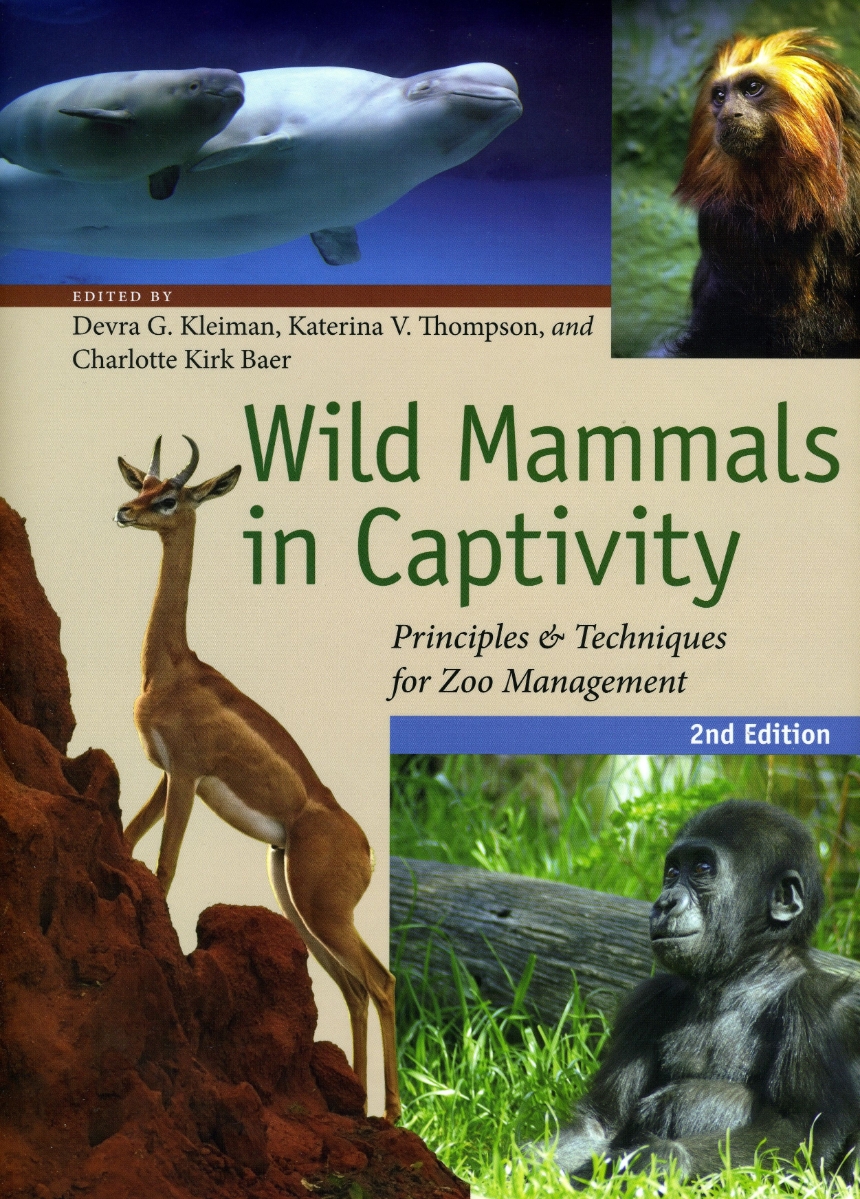Wild Mammals in Captivity
Principles and Techniques for Zoo Management, Second Edition
Second Edition
Wild Mammals in Captivity
Principles and Techniques for Zoo Management, Second Edition
Second Edition
Zoos, aquaria, and wildlife parks are vital centers of animal conservation and management. For nearly fifteen years, these institutions have relied on Wild Mammals in Captivity as the essential reference for their work. Now the book reemerges in a completely updated second edition. Wild Mammals in Captivity presents the most current thinking and practice in the care and management of wild mammals in zoos and other institutions. In one comprehensive volume, the editors have gathered the most current information from studies of animal behavior; advances in captive breeding; research in physiology, genetics, and nutrition; and new thinking in animal management and welfare.
In this edition, more than three-quarters of the text is new, and information from more than seventy-five contributors is thoroughly updated. The standard text for all courses in zoo biology, Wild Mammals in Captivity will, in its new incarnation, continue to be used by zoo managers, animal caretakers, researchers, and anyone with an interest in how to manage animals in captive conditions.
592 pages | 100 halftones, 39 line drawings, 67 tables | 8 1/2 x 11 | © 2010
Biological Sciences: Anatomy, Behavioral Biology, Conservation, Natural History
Reviews
Table of Contents
George Rabb
Preface
Devra G. Kleiman
Acknowledgments
Part One
Ethics and Animal Welfare Standards
Introduction
Devra G. Kleiman
1. Ethics of Keeping Mammals in Zoos and Aquariums
Michael D. Kreger and Michael Hutchins
2. Challenges of Zoo Animal Welfare
Ron Kagan and Jake Veasey
3. Setting Standards for Evaluation of Captive Facilities
Joseph Barber, Denny Lewis, Govindasamy Agoramoorthy, and Miranda F. Stevenson
Part Two
Basic Mammal Management
Introduction
Devra G. Kleiman
4. Physical Methods of Capture, Handling, and Restraint of Mammals
Joe Christman
5. A Framework for Introduction and Socialization Processes for Mammals
David M. Powell
6. Principles of and Research on Environmental Enrichment for Mammals
David Shepherdson
7. Impact of Emerging and Zoonotic Diseases on Mammal Management
Dominic Travis and Robyn Barbiers
8. Safety Considerations in a Zoological Park
Mark Rosenthal and William Xanten
Part Three
Nutrition
Introduction
Charlotte Kirk Baer
9. Contemporary Topics in Wild Mammal Nutrition
Charlotte Kirk Baer, Duane E. Ullrey, Michael L. Schlegel, Govindasamy Agoramoorthy, and David J. Baer
10. Quality Control Aspects of Feeding Wild Mammals in Captivity
Barbara Henry, Michael Maslanka, and Kerri A. Slifka
Part Four
Exhibitry
Introduction
Devra G. Kleiman
11. The History and Principles of Zoo Exhibition
David Hancocks
12. Visitors, Conservation Learning, and the Design of Zoo and Aquarium Experiences
Emily Routman, Jackie Ogden, and Keith Winsten
13. Managing Captive Mammals in Mixed-Species Communities
Jake Veasey and Gabriele Hammer
14. Structural and Keeper Considerations in Exhibit Design
Mark Rosenthal and William A. Xanten
15. How to Develop a Zoo-Based Environmental Enrichment Program: Incorporating Environmental Enrichment into Exhibits
Cynthia Fernandes Cipreste, Cristiano Schetini De Azevedo, and Robert John Young
16. Special Considerations for the Maintenance of Marine Mammals in Captivity
Brian Joseph and James Antrim
17. Zoological Horticulture
Merle Moore and Don Peterkin
18. New and Sustainable Directions in Zoo Exhibit Design
Jon Coe and Greg Dykstra
Part Five
Conservation and Research
Introduction
Devra G. Kleiman
19. Demographic and Genetic Management of Captive Populations
Jonathan D. Ballou, Caroline Lees, Lisa J. Faust, Sarah Long, Colleen Lynch, Laurie Bingaman Lackey, and Thomas J. Foose
20. Regional Collection Planning for Mammals
Ruth Allard, Kevin Willis, Caroline Lees, Brandie Smith, and Bart Hiddinga
21. Management of “Surplus” Animals
Scott Carter and Ron Kagan
22. The Role of Captive Populations in Reintroduction Programs
Joanne M. Earnhardt
23. The Role of Zoos in Contributing to In Situ Conservation
Alexandra Zimmermann
24. Research Trends in Zoos
Terry L. Maple and Meredith J. Bashaw
Part Six
Behavior
Introduction
Katerina V. Thompson
25. The Importance of Maintaining Natural Behaviors in Captive Mammals
M. Elsbeth Mcphee and Kathy Carlstead
26. Animal Learning and Husbandry Training for Management
Jill Mellen and Marty Sevenich Macphee
27. Applying Knowledge of Mammalian Social Organization, Mating Systems, and Communication to Management
Ronald R. Swaisgood and Bruce A. Schulte
28. The Management of Pregnancy and Parturition in Captive Mammals
Patrick Thomas, Cheryl S. Asa, and Michael Hutchins
29. Parental Care and Behavioral Development in Captive Mammals
Katerina V. Thompson, Andrew J. Baker, and Anne M. Baker
30. Data Collection in the Zoo Setting, Emphasizing Behavior
Carolyn M. Crockett and Renee R. Ha
Part Seven
Reproduction
Introduction
Devra G. Kleiman
31. Reproductive Physiology
Cheryl S. Asa
32. Male Reproduction: Assessment, Management, Assisted Breeding, and Fertility Control
Rebecca E. Spindler and David E. Wildt
33. Endocrine Monitoring of Reproduction and Stress
Keith Hodges, Janine Brown, and Michael Heistermann
34. Contraception as a Management Tool for Controlling Surplus Animals
Cheryl S. Asa and Ingrid J. Porton
Appendixes
Introduction
Devra G. Kleiman
Appendix 1: Standard Methods for Measuring Mammals
Barbara Lundrigan
Appendix 2: Identification and Marking Techniques
Penny Kalk and Clifford G. Rice
Appendix 3: Records, Studbooks, Regional Zoo Associations, and ISIS
Laurie Bingaman Lackey
Appendix 4: Annotated Bibliography of Books, Journals, and Web Sites on Captive Management
Kay Kenyon Barboza and Linda L. Coates
List of Contributors
Author Index
Subject Index
Taxonomic Index
